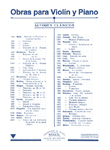Improvisación
De la teoría a la práctica
Armonía
LORENZO DE REIZÁBAL, Arantza; OLABARRIETA, JavierReg.: B.3615
26,00 €
P.V.P. (VAT included 4%)
Add to cart
- Genres: Musical education: Improvisation / Sight reading.
- Language: Español / Castellano
- Language of the comment: Castellano
- Product format: Libro+cd/dvd
- Difficulty level: Intermediate
- Period: 2nd half S. XX - XXI
- Publishing house: Editorial Boileau
- No. of pages: 148
- Measure: 29,50 x 21,00 cm
- ISBN: 978-84-8020-898-7
- ISMN: 979-0-3503-0838-3
- Available in digital: No
- Available for rent: No
This book is the result of a shared need to meet and satisfy a series of voids and concerns arising as a result of our daily teaching practice.
The importance of improvisation in the field of Jazz is a fact without discussion: it is consubstantial with the language itself. It can be said that Jazz is improvisation and that improvisation is Jazz. However, the approach is quite different in the field of classical music. In this sense, we can affirm that, although improvisation has become a conservatory content, it has not yet been conceptualized in all its potential as a practice that allows the development of varied competences, both specific and transversal, fundamental in the training of future music professionals.
Undoubtedly, one of the most developed skills with improvisation is creativity. And, undoubtedly, also, creativity is one of the "star" competitions for a musician, both in his artistic side (as an interpreter or composer) and in his more theoretical side (as a scholar, researcher, etc.). This is already, by itself, a more than sufficient reason to reconsider the importance of improvisation in the training of classical music students. And this is the goal that has been marking and directing, from always, our work as improvisation teachers and that we have shown (at least we have tried) throughout the book: improvisation is an end in itself, but it is also a means for the development of other competences and skills (artistic and otherwise).
On the other hand, books on improvisation there are many and very good, but all come from the field of Jazz, so they handle a very specific and characteristic language. Although we maintain an open and receptive mentality, defending the symbiosis and miscegenation of languages (not in vain one of us belongs to the world of Jazz and another to the world of Classics), we understand that a book of improvisation contemplated was necessary in the market from a musical perspective without labels.
Thus, we believe that this book is novel because it is not installed in any area or closed to any style, it simply teaches how to handle music in an improvised manner. If the book has any merit, it will undoubtedly be that of presenting improvisation with other eyes.
Although it can have a direct application in the classroom (in fact, in the Conservatory we use this type of materials), it is also a book designed for self-learners. Actually, it is a book aimed at anyone who, knowing how to play an instrument, wants to learn to improvise and enjoy creating.
The content of the book is organized in two large blocks. The first of these blocks constitutes a level of basic improvisation in which the triads and quatried chords are worked in all the tonalities; it closes with the pieces of improvisation in different styles of chapter 10. The second block of contents -corresponding to the last three chapters of the book- constitutes a more advanced level of improvisation and focuses on improvisation with secondary dominants and modal improvisation. As in the first block, it closes with a series of pieces to improvise in different styles.
Accompanying the book, a CD is presented with the harmonic bases of all the improvisation activities proposed in each chapter. It is convenient to carry out the activities always following the accompaniment of the CD, with this the student is obliged to maintain a continuous tempo and attention throughout the improvisation, learning to elaborate his musical discourses without interruptions of any kind.
We have written this book in the confidence of being useful as a guide to learn to improvise and as an aid to open the paths towards the awakening of musical creativity and the playful enjoyment of creation. Time will tell us if we have achieved it.
The authors
PRÓLOGO PRESENTACIÓN 1. CONSEJOS PARA IMPROVISAR 1.1 Antes de comenzar a improvisar 1.2 Cuando improvises 2. EL CIFRADO AMERICANO Tabla-resumen de cifrado americano en todas las tonalidades 3. ¡IMPROVISANDO YA! 4. ESTRUCTURAS ARMÓNICAS BÁSICAS Actividades 5. LAS NOTAS REALES Y LAS NOTAS DE ADORNO EN LA IMPROVISACIÓN 5.1 Improvisación con notas reales 5.2 Improvisación con notas de adorno 5.3 Actividades 5.4 Algunos patrones rítmicos para improvisar 6. LAS TONALIDADES Y LA IMPROVISACIÓN 6.1 Improvisar en tonalidades mayores Actividades para improvisar en tonalidades mayores 6.2 Improvisar en tonalidades menores Actividades para improvisar en tonalidades menores 7. ALGUNOS APUNTES SOBRE EL RITMO 7.1 Importancia del ritmo 7.2 Tratamiento del ritmo 7.2.1 Enlace de motivos rítmicos 7.2.2 Ritmo y métrica 7.2.3 Desarrollo rítmico de motivos 7.3 Algunos ritmos característicos 7.4 Actividades 8. CUANDO EL BAJO NO ES LA FUNDAMENTAL Actividades 9. IMPROVISACIÓN SOBRE ACORDES CUATRÍADAS 9.1 La séptima de dominante 9.2 La séptima de sensible 9.3 La séptima disminuida 9.4 Otros acordes de séptima 9.5 Actividades 9.6 Algunos patrones rítmico-melódicos para improvisar con progresiones 10. PIEZAS PARA IMPROVISAR EN DIFERENTES ESTILOS 11. DOMINANTES SECUNDARIAS 11.1 Dominante de la dominante y otras dominantes secundarias 11.2 Dominantes por extensión 11.3 Actividades 12. IMPROVISACIÓN MODAL 12.1 Los modos naturales 12.2 Actividades 13. MÁS PIEZAS PARA IMPROVISAR EN DIFERENTES ESTILOS 14. CODA ANEXOS A.I FÓRMULAS ARMÓNICAS A.II TABLA DE CIFRADOS A.III CÍRCULO DE QUINTAS ÍNDICE DE CONTENIDOS ÍNDICE DE ACTIVIDADES









